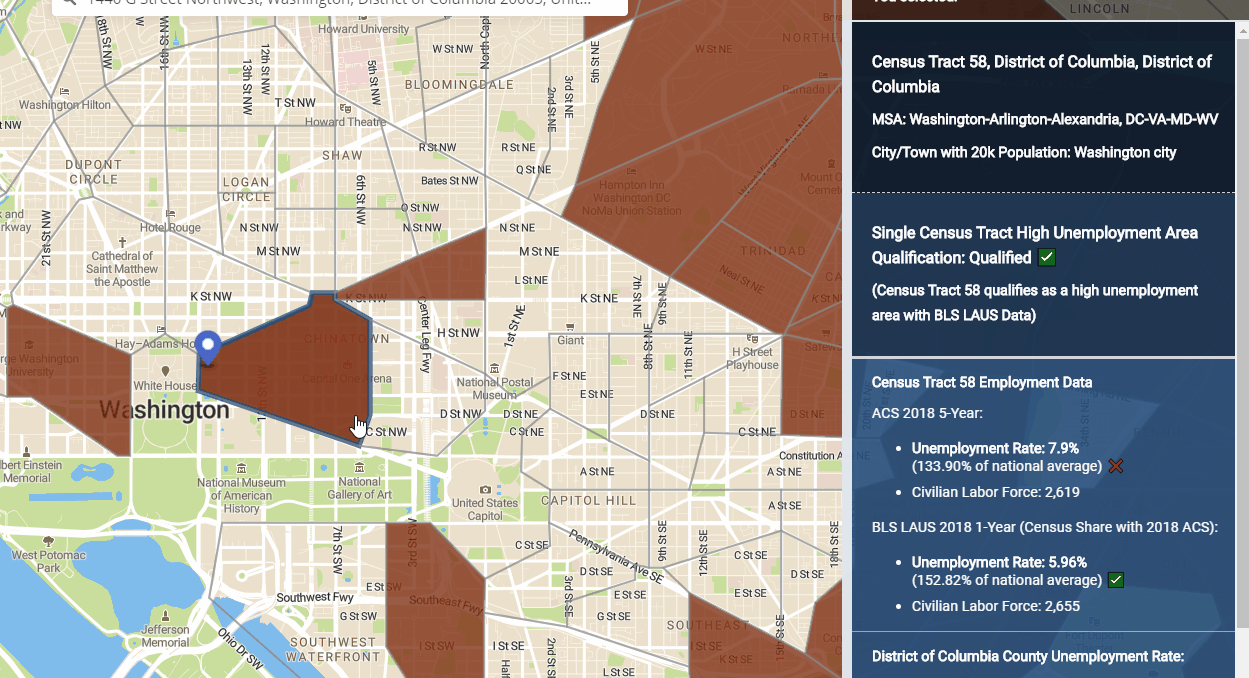MOST RECENT ACS 5-YEAR ESTIMATES
IIUSA published a free mapping tool in December 2019 to inform EB-5 industry stakeholders of critical regulatory changes related to the targeted employment area (TEA) designations.
Earlier this week, we updated the data on our mapping tool with the latest 5-year estimates from the U.S. Census Bureau’s American Community Survey (ACS). With the 2014-2018 ACS data now available, it is critical to use the latest employment statistics to examine qualifications of a high unemployment areas under the EB-5 Program.
Based on the 2018 5-year ACS data, the national average unemployment rate is 5.85%, 0.75% lower than national average from the 2017 5-year ACS estimates. Accordingly, the current unemployment rate threshold to qualify as a high unemployment area is 8.85% (150% of the national average).
BLS DATA IS ALSO AVAILABLE ON THE MAP
According to the final rules that went into effect November 21, 2019, in addition to the new ACS data, USCIS also deems the unemployment statistics provided by the Bureau of Labor Statistics (BLS) “as reliable and verifiable data.” With that, the updated IIUSA TEA mapping tool is also equipped with the 2018 1-year unemployment data from BLS’s Local Area Unemployment Statistics (LAUS), which is the latest BLS data publicly available as of February 2020.
Under the 2018 1-year LAUS data, the national unemployment rate is 3.9%, which means the current threshold of qualifying as a high unemployment area using the LAUS data is 5.85%.
The new TEA mapping tool allows our members the flexibility to investigate the high-unemployment-area qualification of all 73,056 census tracts using both ACS data and LAUS data –of which both datasets are “reliable and verifiable” to USCIS.
NEW FUNCTIONALITIES
Other major updates on our new TEA mapping tool include:
- More in-depth analysis on the qualification of a high unemployment area. The new data panel on the map will tell you whether a selected census tract will independently qualify as a high unemployment area (HUA). Furthermore, if the tract qualifies as a HUA, the data panel also tells you under which dataset (ACS and/or BLS LAUS) the tract’s unemployment rate will meet the required threshold:
- New data panel shows pertinent data on adjacent census tracts. If the selected census tract does not qualify as a high unemployment area by itself, the map show whether there are any high unemployment areas (a “red” census tract) directly adjacent to the tract of your selection. Simply use the map to examine adjacent census tracts and retrieve the unemployment rate as well as the civilian labor force statistics to calculate the weighted average unemployment rate of the entire area.
- Visualization of census tracts located within a high-unemployment county/MSA/city/town. The map also visualizes counties, metropolitan statistical areas (MSAs), cities or towns that will qualify as a high unemployment area in its entirety. If a census tract itself does not meet the high unemployment rate threshold, the map shows you whether a selected tract is located within a high-unemployment county, MSA, or city/town.
- Data on all geographical levels: census tracts, counties, MSAs, and large cities/towns. Click any census tract on the map and the new data panel will provide you with pertinent information on different geographical levels, including:
-
- Census tract’s name and geography (county, city/town, MSA, and state);
- Census tract’s qualification as a high unemployment area;
- Employment rates and labor force statistics not only just for a census tract, but also for the county, MSA, and city/town in which the tract is located.
EXPLORE THE NEW MAPPING TOOL NOW
While IIUSA is pleased to provide the TEA mapping tool to help identify potential high unemployment areas for current or future projects, it is intended for informational purposes only and you should consult with the necessary and qualified EB-5 professionals for an in-depth TEA review and analysis.












